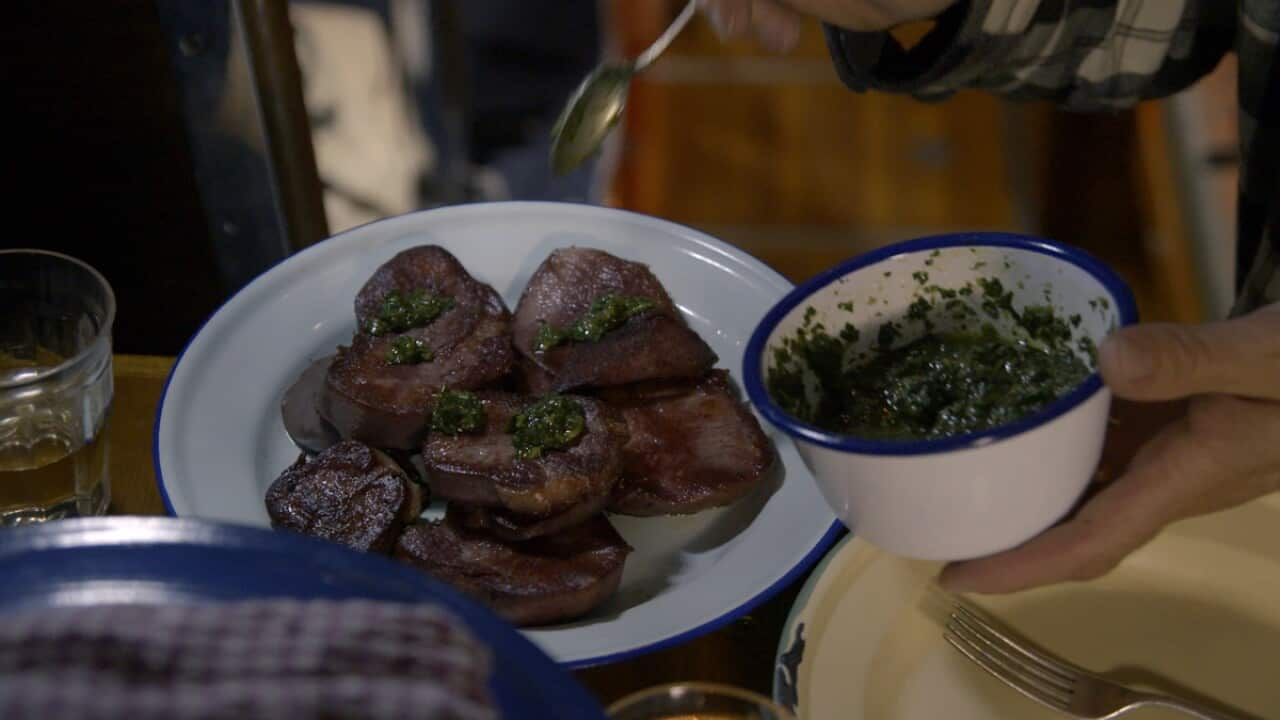When in Rome, you do as the Romans do right? So next time you’re in the Italian capital – or even cooking regional Lazio cuisine at home – how about feasting on a fresh serving of tripe, lamb’s intestines, fried brains or the local delicacy, bull’s testicles?
To the uninitiated offal eater, these cuts of meat may seem somewhat repulsive. But to the people of the ancient city, organ meats are simply divine.
In fact, offal is so highly valued in Rome that the group of unwanted animal cuts has its own term. It’s called the ‘fifth quarter' or cuisine.
The fifth quarter is named as such because it constitutes everything that doesn’t fall within the four main cuts (front and rear) of the animal.
is an Australian-born food blogger who now lives in Italy and runs food tours throughout Rome. As she tells SBS, “when I talk about offal or ‘quinto quarto’ during a food tour of Rome, I see some people scrunching up their noses [in repulsion] at the mere thought of eating offal”.
“However”, she says jokingly, “I am of the mind that you should taste something first and then ask what it was you just ate.”
It’s that sort of positive offal attitude that has made Brancatisano a quinto quarto fan. Quite often, she cooks with offal from her local butcher, and dines out on organ meats regularly at Roman restaurants.
“The fifth quarter is named as such because it constitutes everything that doesn’t fall within the four main cuts (front and rear) of the animal,” Brancatisano tells SBS.
“In a certain sense, the fifth quarter is also hidden, because it is composed largely of internal organs – stomach, tripe, head, tail, tongue, cheeks and so on. Basically, all parts that make an impression on many (to say the least).”
Fifth quarter cuisine: from hardship came culinary creativity
While Italy is a country that’s known for its romantic produce, it’s also one that’s famed for – the poor kitchen. In this light, quinto quarto makes sense.
“The cuisine of the fifth quarter, a fundamental rib of Roman anti-waste gastronomy, was born right in the shadow of the Testaccio slaughterhouse,” she says. “Towards the end of the nineteenth century, the so-called 'vaccinari' or 'scortichini' were those who had the task of skinning cattle. These workers were paid in kind and not in money. The ‘fifth quarter’ was a meagre compensation for their hard work.”
The workers’ wives and cooks at local inns used these unwanted ingredients to create succulent recipes. This led to the birth of quinto quarto cuisine.
It turns out the slaughterhouse workers and their wives were onto something , as offal has been shown to be nutrient-dense. Although the of offal varies according to the animal type and animals’ feed, it is believed to be higher in iron and B12 than lean muscle meats. Organ meats are also rich in highly bioavailable protein, amino acids, zinc, selenium, and vitamins A, D, and B12.
Pick your favourite from these quinto quarto dishes
Even though the fifth quarter was born long ago, quinto quarto is still as popular today as ever. Go to many a fine dining restaurant or trattoria across Rome and you’re sure to find offal being served.
Brancatisano’s top tip to taste the best fifth quarter dishes is to visit the and Trastevere, the closest areas to of the past.
When you’re there, try pajatina: the intestines of an unweaned calf or lamb. “The creamy milk inside the intestines is the characteristic of this recipe,” she says. “As a waiter once passionately told me, ‘that’s the first milk the baby had from its mother’.”
Brancatisano explains that pajatina is mainly served in one of two ways: cooked in tomato sauce and served over rigatoni, or grilled. “In both preparations, combining the enzymes in the intestines with heat causes the mother’s milk inside the casing to curdle. This produces creamy, ricotta-like cheese within.”
Other traditional offal dishes include and animelle, which are sweetbreads (the thymus gland) from calves and lambs.
Two of Brancatisano’s favourite organ meat dishes are (slow-cooked oxtail) and coratella con carciofi. “It’s heart, lungs and livers pan-fried with Rome’s famous artichokes. This can be eaten alone, or is often served also on crostini.”
La cervella, fried brains, are rarer in Rome but it's a dish that's appreciated by adventurous eaters nonetheless. Finally, there’s granelli. These are bull testicles that are cut, breaded and fried. Let’s just say it’s a dish for fifth quarter devotees with strong ambitions to try it all.
If you have intentions to discover Rome's offal flavours, there’s one major point to be aware of. All organ meat needs to be cleaned properly or the harmful bacteria found inside animal intestines could make you sick. Once cleaned though, organ meats are fine to be cooked and eaten.
So when in Rome, go ahead and sample as many fifth quarter dishes as you like from reputable eateries. Or, take a culinary lesson about offal in quinto quarto cuisine from the ancient Romans and cook with cleaned livers, brains or hearts at home.
You only live once. So whether you’re in Rome or Australia, do as the Romans do and eat offal often.










